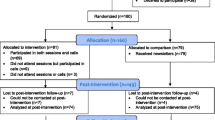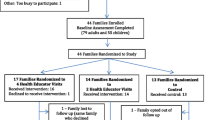Abstract
Healthy Children, Strong Families (HCSF) is a 2-year, community-driven, family-based randomized controlled trial of a healthy lifestyles intervention conducted in partnership with four Wisconsin American Indian tribes. HCSF is composed of 1 year of targeted home visits to deliver nutritional and physical activity curricula. During Year 1, trained community mentors work with 2–5-year-old American Indian children and their primary caregivers to promote goal-based behavior change. During Year 2, intervention families receive monthly newsletters and attend monthly group meetings to participate in activities designed to reinforce and sustain changes made in Year 1. Control families receive only curricula materials during Year 1 and monthly newsletters during Year 2. Each of the two arms of the study comprises 60 families. Primary outcomes are decreased child body mass index (BMI) z-score and decreased primary caregiver BMI. Secondary outcomes include: increased fruit/vegetable consumption, decreased TV viewing, increased physical activity, decreased soda/sweetened drink consumption, improved primary caregiver biochemical indices, and increased primary caregiver self-efficacy to adopt healthy behaviors. Using community-based participatory research and our history of university–tribal partnerships, the community and academic researchers jointly designed this randomized trial. This article describes the study design and data collection strategies, including outcome measures, with emphasis on the communities’ input in all aspects of the research.


Similar content being viewed by others
References
Adams, A. K., Harvey, H., & Brown, D. (2008). Constructs of health and environment inform child obesity prevention in American Indian communities. Obesity, 16, 311–317.
Adams, A. K., Miller-Korth, N., & Brown, D. (2004). Learning to work together: Developing academic and community research partnerships. Wisconsin Medical Journal, 103, 15–19.
Adams, A. K., & Prince, R. J. (2010). Correlates of physical activity in young American Indian Children: Lessons learned from the Wisconsin Nutrition and Growth Study. Journal of Public Health Management Practice, 16, 394–400.
Adams, A. K., Quinn, R. A., & Prince, R. J. (2005). Low recognition of childhood overweight and disease risk among Native-American caregivers. Obesity Research, 13, 146–152.
Armitage, C. J. (2005). Can the theory of planned behavior predict the maintenance of physical activity? Health Psychology, 24, 235–245.
Bandura, A. (2004). Health promotion by social cognitive means. Health Education & Behavior, 31, 143–164.
Baranowski, T., Sprague, D., Baranowski, J. H., & Harrison, J. A. (1991). Accuracy of maternal dietary recall for preschool children. Journal of the American Dietetic Association, 91, 669–674.
Burnet, D., Plaut, A., Courtney, R., & Chin, M. H. (2002). A practical model for preventing type 2 diabetes in minority youth. Diabetes Educator, 28, 779–795.
Centers for Disease Control and Prevention. (2009). Obesity prevalence among low-income, preschool-aged children—United States, 1998–2008. Morbidity and Mortality Weekly Report, 58, 769–773.
Chen, K. Y., & Bassett, D. R., Jr. (2005). The technology of accelerometry-based activity monitors: Current and future. Medicine and Science in Sports and Exercise, 37(11 Suppl), S490–S500.
Diabetes Prevention Program Research Group. (1999). The Diabetes Prevention Program. Design and methods for a clinical trial in the prevention of type 2 diabetes. Diabetes Care, 22, 623–634.
Drummond, J. E., Weir, A. E., & Kysela, G. M. (2002). Home visitation practice: Models, documentation, and evaluation. Public Health Nursing, 19, 21–29.
Epstein, L. H. (1996). Family-based behavioural intervention for obese children. International Journal of Obesity and Related Metabolic Disorders, 20(Suppl 1), S14–S21.
Flynn, M. A., McNeil, D. A., Maloff, B., Mutasingwa, D., Wu, M., Ford, C., et al. (2006). Reducing obesity and related chronic disease risk in children and youth: A synthesis of evidence with ‘best practice’ recommendations. Obesity Reviews, 7(Suppl 1), 7–66.
Golan, M., & Crow, S. (2004). Parents are key players in the prevention and treatment of weight-related problems. Nutrition Reviews, 62, 39–50.
Golan, M., Weizman, A., Apter, A., & Fainaru, M. (1998). Parents as the exclusive agents of change in the treatment of childhood obesity. American Journal of Clinical Nutrition, 67, 1130–1135.
Great Lakes EpiCenter. (2005). Community health data profile: Minnesota, Wisconsin & Michigan tribal communities. Lac du Flambeau, WI: Great Lakes Inter-Tribal Council, Inc.
Jackson, D. M., Reilly, J. J., Kelly, L. A., Montgomery, C., Grant, S., & Paton, J. Y. (2003). Objectively measured physical activity in a representative sample of 3- to 4-year-old children. Obesity Research, 11, 420–425.
Keim, A. (2000). Finding and supporting the best: Using the insights of home visitors and consumers in hiring, training, and supervision. Zero to Three, 21, 37–43.
Koplan, J. P., Liverman, C. T., & Kraak, V. A. (2005). Preventing childhood obesity: Health in the balance. Washington, DC: Institute of Medicine of the National Academies.
LaRowe, T. L., Wubben, D. P., Cronin, K. A., Vannattter, S. M., & Adams, A. K. (2007). Development of a culturally appropriate, home-based nutrition and physical activity curriculum for Wisconsin American Indian families. Preventing Chronic Disease, 4, A109.
Lindsay, R. S., Cook, V., Hanson, R. L., Salbe, A. D., Tataranni, A., & Knowler, W. C. (2002). Early excess weight gain of children in the Pima Indian population. Pediatrics, 109, E33.
Lindsay, A. C., Sussner, K. M., Kim, J., & Gortmaker, S. (2006). The role of parents in preventing childhood obesity. Future of Children, 16, 169–186.
Malcarne, V. L., Chavira, D. A., Fernandez, S., & Liu, P. J. (2006). The scale of ethnic experience: Development and psychometric properties. Journal of Personality Assessment, 86, 150–161.
McIver, P. K., Almeida J., Dowda, M., & Pate R. (2004). Validity of the ActiGraph and Actical accelerometers in 3–5 year-old children. Paper presented at the North American Society for Pediatric Exercise Medicine, St. Andrews, New Brunswick, Canada.
McNaughton, D. B. (2004). Nurse home visits to maternal-child clients: A review of intervention research. Public Health Nursing, 21, 207–219.
Mullenbach, V., Kushi, L. H., Jacobson, C., Gomez-Marin, O., Prineas, R. J., Roth-Yousey, L., et al. (1992). Comparison of 3-day food record and 24-hour recall by telephone for dietary evaluation in adolescents. Journal of the American Dietetic Association, 92, 743–745.
National Center for Health Statistics. (2001). Prevalence of overweight among children and adolescents: United States, 1999. Hyattsville, MD: National Center for Health Statistics.
Polhamus, B., Dalenius, K., Borland, E., Mackintosh, H., Smith, B., & Grummer-Strawn, L. (2009). Pediatric nutrition surveillance 2007 report. Atlanta: U.S. Department of Health and Human Services, Centers for Disease Control and Prevention.
Prevent Child Abuse America. (2003–2012). Healthy Families America. Retrieved September, 22, 2005, from http://www.healthyfamiliesamerica.org/home/index.shtml.
Reilly, J. J., Montgomery, C., Jackson, D., MacRitchie, J., & Armstrong, J. (2001). Energy intake by multiple pass 24 h recall and total energy expenditure: A comparison in a representative sample of 3–4-year-olds. British Journal of Nutrition, 86, 601–605.
Salbe, A. D., Weyer, C., Lindsay, R. S., Ravussin, E., & Tataranni, P. A. (2002). Assessing risk factors for obesity between childhood and adolescence: I. Birth weight, childhood adiposity, parental obesity, insulin, and leptin. Pediatrics, 110, 299–306.
Schwarzer, R., & Jerusalem, M. (1995). Generalized self-efficacy scale. In J. Weinman, S. Wright, & M. Johnston (Eds.), Measures in health psychology: A user’s portfolio (pp. 35–37). Windsor, England: NFER-NELSON.
Schwarzer, R., & Renner, B. (2005). Health-specific self-efficacy scales. Retrieved Oct 15, 2005 from http://userpage.fu-berlin.de/~health/healself.pdf.
St. Jeor, S. T., Perumean-Chaney, S., Sigman-Grant, M., Williams, C., & Foreyt, J. (2002). Family-based interventions for the treatment of childhood obesity. Journal of the American Dietetic Association, 102, 640–644.
Ware, J. E., Kosinki M., Turner-Bowker, D. M., Gandek, B., QualityMetric Incorporated, & New England Medical Center Hospital. Health Assessment Lab. (2005). How to score Version 2 of the SF-12 Health Survey (with a supplement documenting Version 1). Lincoln, RI: QualityMetric Inc.; Boston, MA: Health Assessment Lab.
Williams, K., Prevost, A. T., Griffin, S., Hardeman, W., Hollingworth, W., Spiegelhalter, D., et al. (2004). The ProActive trial protocol—a randomised controlled trial of the efficacy of a family-based, domiciliary intervention programme to increase physical activity among individuals at high risk of diabetes [ISRCTN61323766]. BMC Public Health, 4, 48.
Worobey, J., Pisuk, J., & Decker, K. (2004). Diet and behavior in at-risk children: Evaluation of an early intervention program. Public Health Nursing, 21, 122–127.
Wrotniak, B. H., Epstein, L. H., Paluch, R. A., & Roemmich, J. N. (2004). Parent weight change as a predictor of child weight change in family-based behavioral obesity treatment. Archives of Pediatric & Adolescent Medicine, 158, 342–347.
Zimmerman, M. A., Ramirez-Valles, J., Washienko, K. M., Walter, B., & Dyer, S. (1996). The development of a measure of enculturation for Native American youth. American Journal of Community Psychology, 24, 295–310.
Acknowledgments
This work was supported by a cooperative agreement between the National Heart, Lung, and Blood Institute (U-01 HL087381) and the University of Wisconsin. Additional support was provided by the Wisconsin Partnership Program and the Oneida Nation. We are grateful to the tribal governments of the following communities for supporting this work: the Bad River Band of Lake Superior Chippewa Indians, the Lac du Flambeau Band of Lake Superior Chippewa Indians, the Menominee Nation, and the Oneida Nation. The following key staff and community members assisted the study team and provided advice on ways to implement the study in their communities: Great Lakes Inter-Tribal Council: SuAnne Vannatter and Nancy Miller-Korth. Bad River Band of Lake Superior Chippewa Indians: Mary BigBoy, LuAnn Wiggins, Charlie Wiggins, Mark LeCapitaine, Lori Gregorie, Anne Rosin, Sandy Kolodziejski, and Lin Lemieux. Lac du Flambeau Band of Lake Superior Chippewa Indians: Randy Samuelson, Sue Wolfe, Anita Dionne, Heather Fortin, Hope Williams, Kathy Kinny, Jeanne Wolfe, Stacy Stone, Carol Cardinal, Denise Rheume, Betty Batiste, and Mary White. Menominee Nation: Jerry Waukau, Mark Caskey, Scott Krueger, Michael Skenadore, Dave Hoffman, Brenda Hoffman, Jean Cox, Jeanette Perez, Sue Blodgett, Mary Waukau, Bethany Miller, and Mary Lawe. Oneida Nation: Eric Krawczyk, Tina Jacobsen, Dawn Krines Glatt, Jill Caelwaerts, Monique Gore, Susan Higgs, Karla Jenquin, Jenny Jorgensen, Charlene Kizior, and Michelle Mielke. University of Wisconsin–Green Bay: Joelle Frank and Stephanie Jansen. University of Wisconsin School of Medicine: Heather Lukolyo.
Author information
Authors and Affiliations
Corresponding author
Rights and permissions
About this article
Cite this article
Adams, A.K., LaRowe, T.L., Cronin, K.A. et al. The Healthy Children, Strong Families Intervention: Design and Community Participation. J Primary Prevent 33, 175–185 (2012). https://doi.org/10.1007/s10935-012-0275-y
Published:
Issue Date:
DOI: https://doi.org/10.1007/s10935-012-0275-y




